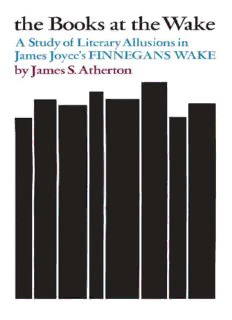
The books at the wake: a study of literary allusions in James Joyce's Finnegans wake PDF
Preview The books at the wake: a study of literary allusions in James Joyce's Finnegans wake
the Books at the Wake A Study of Literary Allusions in James Joyce's FINNEGANS WAKE by James S. Atherton THE BOOI(S AT THE WAKE A Study of Literary Allusions . 'in James Joyci's Finnegans Wake by JAMES S. ATHERTON SOUTHERN ILLINOIS UNIVERSITY PRESS Cm'bondale Copyright © 1959, 2009 by James S. Atherton All rights reserved Printed in the United States of America 12 11 10 09 4 3 2 1 The Library of Congress has cataloged the original issue of this book as follows: Atherton, James S. The books at the wake; a study of literary allusions in James Joyce’s Finnegans wake. Bibliography: p. 1. Joyce, James, 1882–1941. Finnegans wake—Sources. 2. Joyce, James, 1882–1941—Allusions. I. Title. [PR6019.09F55 1974] 823'.9'12 74-5407 ISBN 978-0-8093-0687-9 ISBN 0-8093-0687-5 ISBN 978-0-8093-2933-5 ISBN 0-8093-2933-6 The paper used in this publication meets the minimum requirements of American National Standard for Information Sciences—Permanence of Paper for Printed Library Materials, ANSI Z39.48-1992. ∞ Contents Introduction page II PART 1. THE STRUCTURAL BOOKS 27 PART II. THE LITERARY SOURCES I. The Manuscripts 59 2. Some typical books 72 3. The Irish writers 89 4. Swift, a paradigm of a God II4 5. Carroll, the unforeseen precursor 124 6. The Fathers 137 7. 'The world's a stage' 149 PART III. THE SACRED BOOKS 8. The Old Testament 169 9. The New Testament 181 10. The 184 II. The Book of the Dead 191 12. The Koran 201 13. The Eddas 218 14. Other Sacred Books 224 PART IV. APPENDIX AND BIBLIOGRAPHIES Appendix: Alphabetical list of literary allusions 233 Bibliography I: Books 291 Bibliography II: Articles in periodicals 294 Index 297 7 Acknowledgements My thanks are first due to my friend since schooldays, the late Arnold Davenport, Senior Lecturer in English Literature at Liverpool uni versity, without whose encouragement this book would never have been started, and under whose guidance much of it was written as a disserta tion towards the degree of M.A. I am also deeply indebted to two other friends: Adaline Glasheen, the author of A Census ofF innegans Wake, with whom I have exchanged letters almost weekly for the past six years and who has given me an enormous amount of information on Joycean topics; and M. J. C. Hodgart, of Pembroke College, Cambridge, the chief academic authority on Finnegans Wake in this country, of whose work I have made con siderable use, and who has given me much valuable advice, particularly on Joyce's use of the Sacred Books. A more recent friend, but an equally keen Joycean, Fritz Senn-Baldinger, of ZUrich, must also be thanked-both for the information he has given me on Joyce's use of Swiss-German and ZUrich, and for kindly offering to prepare the index. Writing a book of this kind makes inordinate demands on libraries. I am grateful to the librarians and staffs of the Wigan Public Library, the Harold Cohen Library at Liverpool University, and the British Museum Library for their unfailing courtesy and helpfulness. Thanks are also due to the editors of English Studies and Comparative Literature for permission to use material which has already appeared in their journals; and to the James Joyce Trustees for permission to quote from Finnegans Wake. 9 Introduction 'An argument/ollows' (222.21) P erhaps-this must be the first word on such a subject-a final literary evaluation of Finnegans Wake will never be made, for any such evaluation must follow and be based upon a complete understanding of the book. No such understanding has yet been reached and none seems to be in sight in spite of the increasing flow of illustrative material. The article on James Joyce in the current edition of the Encyclopaedia Britannica correcdy describes Finnegans Wake as 'the extreme of obscurity in modern literature', and might have added that it is not only extremely obscure but extremely long. Joyce worked at it for over seventeen years, often spending more than fourteen hours a day in composition and revision. To read through the book once is a full-time occupation for a week, providing that the reader is prepared to continue reading without pausing to consider the meaning of the words before him. If he does stop to consider there is no limit to the time he may spend; indeed Joyce claimed that he expected his readers to devote their lives to his book. Since its first publication in 1939 several hundreds of articles and over thirty books have appeared explaining its profundities from v:u.;ous view1'oints and in varying ways, but agreement has still not been reached on many fundamental points. Indeed as research continues more complexities are found and a considerable amount of odium theologicum seems to be arising between the chief exegetes. Even the basic plot or groundwork of the book has not been estab lished with certainty. The most influential early attempt to explain the Wake to the reading public was Edmund Wilson's article 'The Dream of H. C. Earwicker' afterwards published in The Wound and the Bow.1 Wilson said that the whole book was an account of a dream by a drunken publican in Chapelizod. Joyce remarked at the time in a letter to Frank Budgen which has only just been published2 that 'Wilson Edmund Wilson, The Wound and the Bow. See Bibliography. 1 ~ Stuart Gilbert (Editor), The Letters of James Joyce. London: Faber and Faber, I957, p. 405. Letter dated 'End July 1939'. (New York: Viking.) II
Description: